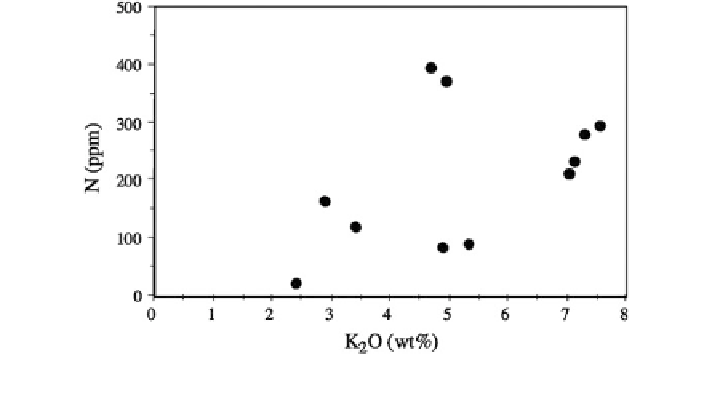Geology Reference
In-Depth Information
Fig. 5.3 Covariation of K
2
O and N content of whole ultrapotassic rocks from the Damodar valley.
Data in Table
5.1
worldwide (Bergman 1987). Ultrama
c lamprophyre from the Raniganj basin
feature greater SiO
2
but lower TiO
2
,P
2
O
5
, and K
2
TiO2, Lamproites and lamprophyres
from the Damodar valley, have the combination of extreme REE abundances
(1,019
-
5,400 ppm), with strongly fractionated REE, where La/Sm
cn
= 3.5
-
5.6 and
GD/Yb
cn
=7.3
18, consistent with residual garnet in the source (Table
5.2
, one
outlier KH-2). There is an in
-
Sm, as observed in
other studies of lamproites from the Damodar valley (Rock et al. 1992). On
primitive mantle-normalized diagrams, the Damodar Ultrapotassic suite shows: (1)
normalized depletions of Cs and Rb relative to Ba and Th; (2) negative anomalies at
Nb
ection in the REE patterns at Nd
-
Hf, and Ti; and (3) Nb/Ta and Zr/Hf ratios that are in general
variably greater than the respective primitive mantle values of 17 and 36, as is seen
in mantle alkaline and carbonic magmas. The Andhra Pradesh lamproite is dis-
tinctive in greater abundances of Cs and Rb, with no or diminished negative
anomalies at Nb
Ta, Pb, P, Zr
-
-
Ta, Zr
Hf, and Ti (Table
5.2
and Fig.
5.4
)
-
-
5.2 The REE and Minor Element Geochemistry of Birunga
and Toro-ankole Rocks
The REE and trace element geochemistry of K-rich volcanic rocks from Birunga
and Toro Ankole was studied in detail by Higazy (1954), Bell and Powell (1969),
De Mulder (1985), Rogers et al. (1985) and Rogers (1992). It is observed that these
rocks are enriched in such mantle incompatible elements as Ba (100
-
7,000 ppm),
Rb (150
3,000 ppm), Sr (4,500
9,500 ppm) and Zr (800
1,200 ppm). The more
-
-
-
ultrama
230 ppm), Co
(65
-
85 ppm) and Cr (290
-
650 ppm). In some of the Mg
-
poor melilite leucitite and
c variety is rich in such compatible elements as Ni (100
-

Search WWH ::

Custom Search